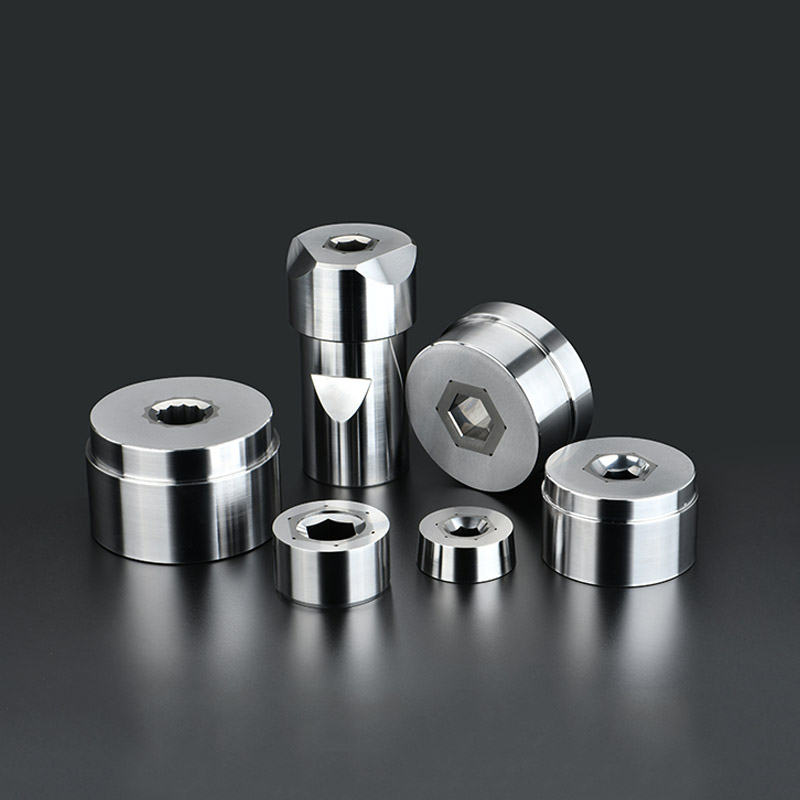A Cold Heading Mold is a specialized tool used in the metal forming industry to manufacture fasteners, bolts, screws, rivets, and other metal components through a process called Cold Heading or cold forging. Unlike traditional machining, cold heading does not require cutting the material. Instead, it shapes the metal at room temperature by applying high pressure, which enhances the material's strength, reduces waste, and increases production efficiency.

Materials Used in Cold Heading Mold
The choice of material is critical for the durability and performance of a cold heading mold. Common materials include:
High-Speed Steel (HSS): Known for excellent hardness, wear resistance, and toughness, suitable for medium-volume production.
Alloy Tool Steel (D2, A2, O1): Offers high resistance to wear and deformation, often used for high-precision molds.
Carbide: Extremely hard and wear-resistant, ideal for high-volume or abrasive material forming.
Additionally, surface treatment like nitriding or PVD coating can extend the mold’s lifespan and reduce friction during the cold heading process.
Steps to Make a Cold Heading Mold
Creating a high-quality Cold Heading Die requires precision and expertise. The general steps are as follows:
Design and Drawing:
Engineers create a detailed 3D model of the mold based on the component’s dimensions, material type, and production volume. CAD software ensures accuracy and consistency.Material Selection and Preparation:
The tool steel or carbide is cut to the required size. Stress relief treatment may be applied to minimize deformation during machining.Rough Machining:
The basic shape of the mold is machined using CNC milling or turning machines.Heat Treatment:
The mold is hardened and tempered to achieve the required hardness and durability.Precision Grinding and Polishing:
High-precision grinding machines and polishing tools are used to achieve a smooth surface finish, which is critical for consistent cold forging performance.Assembly and Testing:
For multi-part molds, components are assembled, and trial production runs are conducted. Adjustments are made to ensure the mold produces parts with accurate dimensions and excellent surface quality.
Precautions When Making a Cold Heading Mold
Ensure accurate tolerance control; even small deviations can affect part quality.
Use proper cooling and lubrication during machining to prevent overheating and micro-cracks.
Regularly inspect molds for wear and replace or refurbish them to maintain production efficiency.
Consider material compatibility; some metals require harder molds to prevent premature wear.
Applications of Cold Heading Molds
Cold heading molds are widely used across industries due to their efficiency and precision. Typical applications include:
Automotive Industry: Manufacturing bolts, nuts, and fasteners for engines, chassis, and suspension systems.
Electronics: Producing tiny screws and pins for smartphones, laptops, and other electronic devices.
Construction: Mass production of fasteners for building materials.
Aerospace: High-precision components that require strength and fatigue resistance.
Additionally, custom cold heading molds can be designed for specialized metal forming applications, meeting unique size, shape, and material requirements.
A cold heading mold is an essential tool in modern manufacturing, combining efficiency, precision, and durability. Proper material selection, careful design, precise machining, and regular maintenance are key to producing high-quality molds. Whether for automotive, electronics, construction, or aerospace applications, Cold Heading Dies enable high-volume production of strong, reliable metal components.
By choosing a trusted supplier and using high-precision cold heading molds, manufacturers can optimize production efficiency while maintaining excellent product quality.











